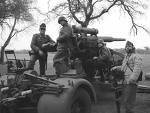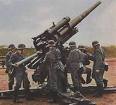Thanks for your work ¡
you could also type the articel in german in to the google translator and get a decent translaton.=) Good articel, nice job.
The German eighty-eight is probably the the best known artillery piece in world war 2. The name applies to a series of of anti-aircraft guns officialy called the 8.8 cm Flak 18, 36 or 37, and could also include newer and more power models, the Flak 41 and 43, although these were different weapons. Flak is a german contraction of either (Flieger)a(bwehr)k(anone) or Flugabwehr-Kanone (hence the capital K, nowadays one word) meaning anti-aircraft gun, the original purpose of the eighty-eight.

Succes as an improvised anti-tank gun led to a seperate line of guns for anti-tank use, referred to as PaK88 and as the main armament for tanks such as the tiger .

In informal German use, the guns were universally known as the Acht-acht, a contraction of Acht-komma-acht Zentimeter. The German word “Flak” was the preferred Allied term for German AA fir.
The forces of the Third Reich employed the 88 extensively in World War II, not only in its original role as an anti-aircraft gun, where it performed well, but also as an anti-tank gun. Throughout the war the gun had few rivals.

Erwin Rommel helped develop the 88 as an anti-tank weapon, first in France and later in North-Africa. His timely used to the gun to blunt the British advance at Arras ended ended any hope of a breakout from the blitzkriegencirclememnt of May 1940. In Libya and Egypt, he lured British tanks into traps by baiting them with apparently retreating panzers. When the British pursued, concealed 88s picked them of far beyond of the two and six pound turret guns of the british marks. The unparaled penetration of the 88’s shell destroyed many Allied tanks and other armoured vehicles. The British 8th Army eventually learned to coordinate their heavy artillary with their ground advances, destroying the relatively immobile 88s in their replacements once they revealed their position.
Does anybody of you know how effective the German AA was during the WWII ?
2cm (quadruple) and 3,7cm were good weapons at short and mid ranges and low altitide attacks against FLAK of this caliber was always feared by the allied. Í have read a report from a P-47 pilot who stated that there it was nearly impossible not to get hit.
the bigger guns like the 8,8cm 10,5cm and 12,5cm for sure were also well built cannons, but the effectiveness against high flying bombers was not too overwhelming. I think it was between 2,5 and 5% of all losses by heavy AAA.
jens
The 8,8 and 10,5 cm were extremely efective , especially if the aircraft was flying over 2000 meters and no more than 7000 meters.

WOW ! what a picture! I wonder how long that noseless B-17 kept going before it crashed?
Not much.
Hi.
Heavy anti aircraft artillery was not really effective. Ok, a direct hit was able to destroy any plane but the number of grenades needed to destroy one plane was very large:
8,8 cm Flak 18/36/37: 14.000 rounds
8,8 cm Flak 41: 8.500 rounds
10,5 cm Flak 39: 6.000 rounds
12,8 cm Flak 40: 3.000 rounds
The statistical ammunition consumption for one month in 1944 only for the homeland defence units was:
1.749.300 rounds 8,8 cm
199.800 rounds 10,5 cm
73.700 rounds 12,8 cm
The main task of heavy aaa was to disturb the bomber crews while aiming and to break up formations for the fighters.
Yours
tom! 
8,8 cm Flak 18/36/37: 14.000 rounds
Hmm, that figure seems plain wrong to me, remember that the 88mm as much like th 105 and 128 mm did not requira dirrect hit to damage a plane, with the schrapel effect the “area” of the shot was much wider than the caliber of the weapon.

Unless the flight engineer had secondary controls, it will make it all the way to the scene of the crash. (credit to Ron White)
Hi.
The statistic is based on Luftwaffe evaluations which are avaliable at the Bundesarchiv Freiburg. It is as it is. 
During the innitial stages of the war the Flak 18 needed 16.000 rounds for one kill using time fuzes only. In 1944 only 12.000 rounds were needed due to improved fire control (Funkmessorter etc.) and use of combined impact and time fuzes.
The lower numbers for the Flak 41 ammunition compared to the Flak 18/36/37 ammunition is caused by the use of the combined fuzes immediately after introduction and the higher accuracy due to the higher muzzle velocity.
Yours
tom! 
lmao :shock:
Glad you liked it, Couldnt resist the Ron White line…
These are some great pics of the 88. Was the 88 used by any nations after WWII?
Yeap, it was used by the former Yugoslavian nations well into the 1990s.
This is not a B-17 . It’s a bit old but i just saw it
I think you all know the movie Band Of Brothers . Right ? Well in this movie there
is one more proof about the fear the 88 cause to the Allies . Before the battle at city of Foy , the 101st Airborne was Bois Jacques . There the German artillery with at liest one 88 killed many men . This was the fearest enemy after the cold
not sure if this will help



